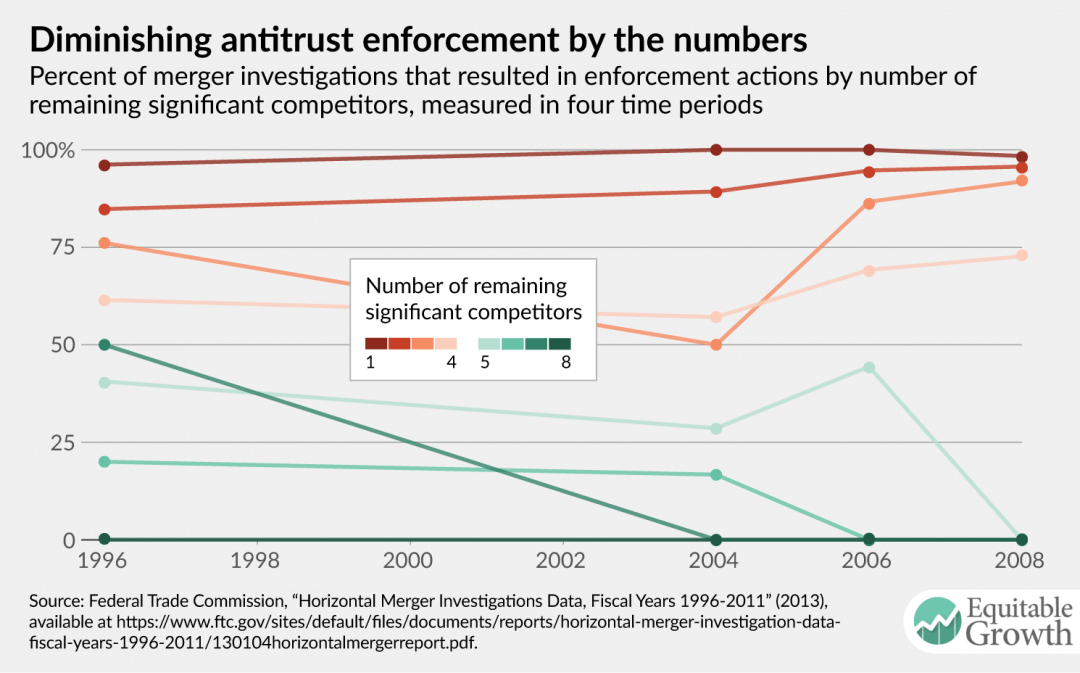Understanding the importance of antitrust policy for U.S. economic competitiveness and consumer choice

In a new paper in the Washington Center for Equitable Growth’s ongoing series on antitrust policy and its implications for the economic well-being of U.S. workers and consumers, John E. Kwoka of Northeastern University documents the rise in industry concentration and examines the evidence for one possible explanation: the change in merger enforcement policy at the Federal Trade Commission, or FTC, and the Antitrust Division of the U.S. Department of Justice.
Kwoka examines FTC enforcement data from the mid-1990s through 2011, finding that enforcement rates for mergers that would result in four or fewer significant competitors not only remained high but also increased marginally over that time. But for mergers where the number of remaining significant competitors was more than four, enforcement not only fell over the analyzed time period but also had literally ceased by 2007.
Figure 1

While Kwoka acknowledges the limitation of the data, which only cover FTC actions, not the Department of Justice, and don’t extend fully to the present time, it is noteworthy that these findings are consistent with several well-known real world examples of consolidation, such as the telecommunications industry, dominated by four companies, as well as the airline industry. As Kwoka points out, only 10 years ago, there were six major legacy airlines, plus Southwest and several low-cost carriers. In 2008, the Department of Justice permitted the merger of Delta and Northwest to move forward, setting off a wave of mergers in the industry that has left us today with only four significant competitors and severely curtailed consumer choice.
These findings are all the more interesting in light of earlier research that Kwoka has done. He has examined the level of concentration at which anti-competitive outcomes become nearly certain, finding that prices rose in nearly 95 percent of instances of mergers that resulted in six or fewer remaining significant competitors. As Kwoka himself notes, “It is notable, therefore, that it is in precisely this range of five to seven significant competitors where enforcement policy has shifted so dramatically in the past 20 years.”
The antitrust enforcement line, therefore, has effectively been drawn in the wrong place. The consequences of using four remaining significant competitors rather than six have led to rising concentration and harm to competition and consumers.
Kwoka mentions several explanations for this shift in merger enforcement policy, including agency budget constraints. The explanation he focuses on is changes in antitrust policy’s presumptions about the competitive consequences of increases in concentration.
Over the past 50 years, those presumptions shifted from a viewpoint that held that even modest increases in concentration would result in above-competitive prices and profits to one in which it was believed that tougher merger standards sacrificed cost efficiencies, which presumably would be passed along to consumers. While antitrust policy has moderated somewhat from that so-called Chicago school view, the FTC enforcement data from 1996 through 2011 nonetheless demonstrate that there has continued to be a shift away from merger enforcement actions in all but the most concentrated markets.
Furthermore, while the latest merger guidelines, published in 2010, emphasize the multiplicity of relevant factors beyond just cost efficiencies in evaluating the likelihood of possible harms from a merger, they also further relax the thresholds for the levels and changes in concentration at which a merger might be presumed to lessen competition.
Kwoka concludes by calling for the strengthening of antitrust policy by revisiting policy decisions about which standards to use when considering merger proposals to ensure that policy hasn’t diverged from the evidence. This will also require investing in further analytical and empirical work to inform that decision-making. In addition, agency budgets need to be expanded to ensure that they have adequate resources to vigorously pursue the merger cases that raise these concerns.

